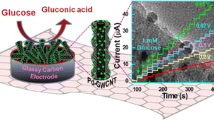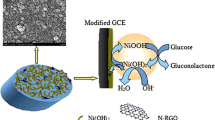Abstract
We describe an anodic stripping voltammetric (ASV) method for glucose sensing that widely expands the typical amperometric i-t response of glucose sensors. The electrode is based on a working electrode consisting of a glassy carbon electrode modified with Pt-Pd nanoparticles (NPs; in an atomic ratio of 3:1) on a reduced graphene oxide (rGO) support. The material was prepared via the spontaneous redox reaction between rGO, PdCl4 2− and PtCl4 2− without any additional reductant or surfactant. Unlike known Pt-based sensors, the use of Pt3Pd NPs results in an ultrasensitive ASV approach for sensing glucose even at near-neutral pH values. If operated at a working voltage as low as 0.06 V (vs. SCE), the modified electrode can detect glucose in the 2 nM to 300 μM concentration range. The lowest detectable concentration is 2 nM which is much lower than the LODs obtained with other amperometric i-t type sensing approaches, most of which have LODs at a μM level. The sensor is not interfered by the presence of 0.1 M of NaCl.

We describe an anodic stripping voltammetric method for glucose sensing that widely expands the typical amperometric i-t response of glucose sensors (2 nM to 300 μM). The electrode is based on a glassy carbon electrode modified with Pt-Pd nanoparticles on a reduced graphene oxide (rGO) support.




Similar content being viewed by others
References
Sanna G, Pilo M, Piu P, Tapparo A, Seeber R (2000) Determination of heavy metals in honey by anodic stripping voltammetry at microelectrodes. Anal Chim Acta 415:165
Kalvoda R (1990) Contemporary Electroanalytical Chemistry: Springer pp 403
Copeland T, Skogerboe R (1974) Anodic stripping voltammetry. Anal Chem 46:1257
Wang J (2006) Analytic al electrochemistry:John Wiley & Sons pp 86
Wang J, Lu J, Hocevar SB, Farias PA, Ogorevc B (2000) Bismuth-coated carbon electrodes for anodic stripping voltammetry. Anal Chem 72:3218
Wang J (2005) Stripping analysis at bismuth electrodes: a review. Electroanalysis 17:1341
Wang J (2001) Glucose biosensors: 40 years of advances and challenges. Electroanalysis 13:983
Chen C, Xie Q, Yang D, Xiao H, Fu Y, Tan Y, Yao S (2013) Recent advances in electrochemical glucose biosensors: a review. RSC Adv 3:4473
Toghill K, Compton R (2010) Electrochemical non-enzymatic glucose sensors: a perspective and an evaluation. Int J Electrochem Sci 5:1246
Wang G, He X, Wang L, Gu A, Huang Y, Fang B, Geng B, Zhang X (2013) Non-enzymatic electrochemical sensing of glucose. Microchim Acta 180:161
Chen X, Wu G, Cai Z, Oyama M, Chen X (2014) Advances in enzyme-free electrochemical sensors for hydrogen peroxide, glucose, and uric acid. Microchim Acta 181:689
Wu G, Song X, Wu Y, Chen X, Luo F, Chen X (2013) Non-enzymatic electrochemical glucose sensor based on platinum nanoflowers supported on graphene oxide. Talanta 105:379
Zhao Y, Fan L, Gao D, Ren J, Bo H (2015) High-power non-enzymatic glucose biofuel cells based on three-dimensional platinum nanoclusters immobilized on multiwalled carbon nanotubes. Electrochim Acta 145:159
Meng L, Jin J, Yang G, Lu T, Zhang H, Cai C (2009) Nonenzymatic electrochemical detection of glucose based on palladium-single-walled carbon nanotube hybrid nanostructures. Anal Chem 81:7271
Ye J, Chen C, Lee C (2015) Pd nanocube as non-enzymatic glucose sensor. Sens Actuators B-Chem 208:569
Kurniawan F, Tsakova V, Mirsky V (2006) Gold nanoparticles in nonenzymatic electrochemical detection of sugars. Electroanalysis 18:1937
Ismail N, Lea Q, Yoshikawaa H, Saitoa M, Tamiyaa E (2014) Development of non-enzymatic electrochemical glucose sensor based on graphene oxide nanoribbon-gold nanoparticle hybrid. Electrochim Acta 146:98
Beden B, Largeaud F, Kokoh K, Lamy C (1996) Fourier transform infrared reflectance spectroscopic investigation of the electrocatalytic oxidation of D-glucose: identification of reactive intermediates and reaction products. Electrochim Acta 41:701
Burke L (1994) Premonolayer oxidation and its role in electrocatalysis. Electrochim Acta 39:1841
Rao M, Drake R (1969) Studies of electrooxidation of dextrose in neutral media. J Electrochem Soc 116:334
Zhang H, Jin M, Xia Y (2012) Enhancing the catalytic and electrocatalytic properties of Pt-based catalysts by forming bimetallic nanocrystals with Pd. Chem Soc Rev 41:8035
Wu G, Huang H, Chen X, Cai Z, Jiang Y, Chen X (2013) Facile synthesis of clean Pt nanoparticles supported on reduced graphene oxide composites: Their growth mechanism and tuning of their methanol electro-catalytic oxidation property. Electrochim Acta 111:779
Cote L, Kim F, Huang J (2008) Langmuir-Blodgett assembly of graphite oxide single layers. J Am Chem Soc 131:1043
Wang J, Thomas D, Chen A (2008) Nonenzymatic electrochemical glucose sensor based on nanoporous PtPb networks. Anal Chem 80:997
Chen L, Tang Y, Wang K, Liu C, Luo S (2011) Direct electrodeposition of reduced graphene oxide on glassy carbon electrode and its electrochemical application. Electrochem Commun 13:133
Xiao F, Zhao F, Mei D, Mo Z, Zeng B (2009) Nonenzymatic glucose sensor based on ultrasonic-electrodeposition of bimetallic PtM (M = Ru, Pd and Au) nanoparticles on carbon nanotubes-ionic liquid composite film. Biosens Bioelectron 24:3481
Park S, Chung T, Kim H (2003) Nonenzymatic glucose detection using mesoporous platinum. Anal Chem 75:3046
Chen X, Lin Z, Chen D, Jia T, Cai Z, Wang X, Chen X, Chen G, Oyama M (2010) Nonenzymatic amperometric sensing of glucose by using palladium nanoparticles supported on functional carbon nanotubes. Biosens Bioelectron 25:1803
Chen X, Wu G, Chen J, Chen X, Xie Z, Wang X (2011) Synthesis of “clean” and well-dispersive Pd nanoparticles with excellent electrocatalytic property on graphene oxide. J Am Chem Soc 133:3693
Acknowledgments
This research work was financially supported by the National Nature Scientific Foundation of China (21175112 and 21375112), which are gratefully acknowledged. Professor John Hodgkiss of The University of Hong Kong is thanked for his assistance with English.
Author information
Authors and Affiliations
Corresponding author
Electronic supplementary material
Below is the link to the electronic supplementary material.
ESM 1
(DOC 254 kb)
Rights and permissions
About this article
Cite this article
Zhao, L., Wu, G., Cai, Z. et al. Ultrasensitive non-enzymatic glucose sensing at near-neutral pH values via anodic stripping voltammetry using a glassy carbon electrode modified with Pt3Pd nanoparticles and reduced graphene oxide. Microchim Acta 182, 2055–2060 (2015). https://doi.org/10.1007/s00604-015-1555-z
Received:
Accepted:
Published:
Issue Date:
DOI: https://doi.org/10.1007/s00604-015-1555-z




